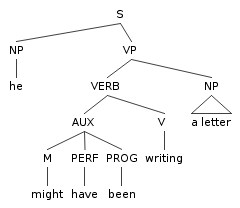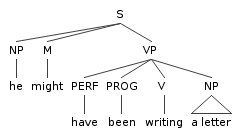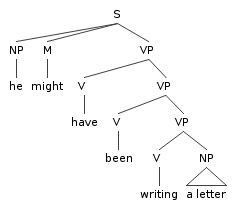Consider the sentence:
-
(1) He might have been writing a letter
(2) Chomsky (1957)
(3) Chomsky LSLT (1955)
(4) Chomsky Studies (1972)
(5) Jackendoff (1972)
(6) Our text, exercises Ch 6, inherited from Emonds (1976)
(7) Speaker A: What might he have been doing?
Speaker B: Writing a letter. Been writing a letter. Have been writing a letter.
(8) (a) He might have been writing a letter or watching TV. (b) He might have been writing a letter or been watching TV. (c) He might have been writing a letter or have been watching TV.
(9) (a) Mary thinks he might have been writing a letter and so he might have been. (b) Mary thinks he might have been writing a letter and so he might have. (c) Mary thinks he might have been writing a letter and so he might.
(10)
Speaker A: Do you think he might have been writing a letter?
Speaker B:
(a) Yes, he might have been.
(b) Yes, he might have.
(c) Yes, He might.
Model answer
We begin by considering each of the examples in turn.
(7) Speaker A: What might he have been doing?These are standalone fragments, We assume that standalone fragments are constituents. Therefore these examples argue for the constituency of writing a letter, been writing a letter, and have been writing a letter, repectively.
Speaker B: (a) Writing a letter. (b) Been writing a letter. (c) Have been writing a letter.
(8) (a) He might have been writing a letter or watching TV. (b) He might have been writing a letter or been watching TV. (c) He might have been writing a letter or have been watching TV.
(9) (a) Mary thinks he might have been writing a letter and so he might have been. (b) Mary thinks he might have been writing a letter and so he might have. (c) Mary thinks he might have been writing a letter and so he might.
(9) (a) ... and so he might have been. [so = writing a letter] (b) ... and so he might have. [so = been writing a letter] (c) ... and so he might. [so = have been writing a letter]Therefore these examples argue for the constituency of writing a letter, been writing a letter, and have been writing a letter, repectively.
(10)
Speaker A: Do you think he might have been writing a letter?
Speaker B:
(a) Yes, he might have been.
(b) Yes, he might have.
(c) Yes, He might.
(9) (a) Yes, he might have been 0. [0 = writing a letter] (b) Yes, he might have 0. [0 = been writing a letter] (c) Yes, he might 0. [0 = have been writing a letter]Therefore these examples argue for the constituency of writing a letter, been writing a letter, and have been writing a letter, repectively.
Summarizing the data, all the (a) examples argue for the constituency of writing a letter, all the (b) examples argue for the constituency of been writing a letter, and all the (c) examples argue for the constituency of and have been writing a letter.
The proposals in (2)-(6) differ considerably in their constituency claims. The following table summarizes how they line up with the data:
| Constituent | Consistent Analysis | Evidence |
| writing a letter | 3,4,6 | (7a), (8a) (9a), (10a) |
| been writing a letter | 6 | (7b), (8b) (9b), (10b ) |
| have been writing a letter | 5,6 | (7c), (8c) (9c), (10c) |




